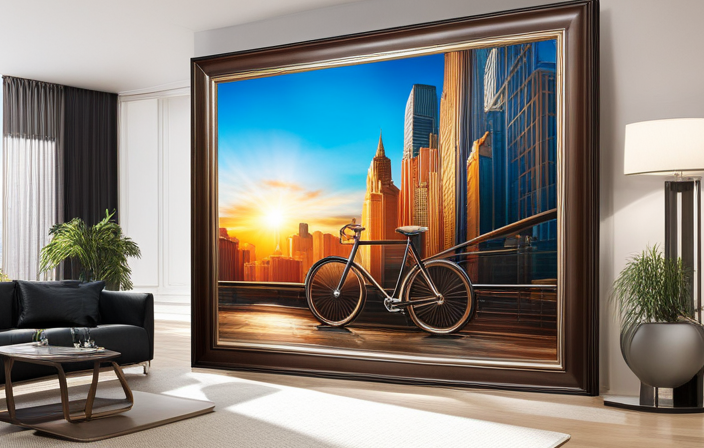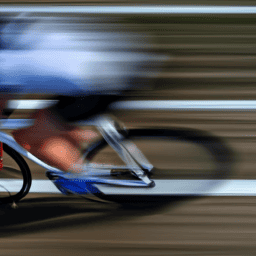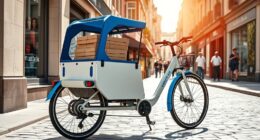When the moon is high in the midnight sky and the city streets are immersed in darkness, the excitement of cycling at night beckons me.
But in this enchanting adventure, safety must never be forgotten. In this article, I will share essential tips and tricks to ensure your journey under the stars is both enjoyable and secure.
From the importance of reflective gear to observing traffic laws, let’s embark on a nocturnal cycling expedition like no other.
Key Takeaways
- Be aware of potential hazards and dangers while riding at night, such as obstacles, pedestrians, and animals crossing your path unexpectedly.
- Take precautions to avoid collisions with vehicles, especially at intersections, and anticipate the actions of other road users.
- Check your bicycle before riding at night, ensuring proper tire pressure, working lights and reflectors, functioning brakes, and smooth gears.
- Plan your route carefully, choosing well-lit and safe roads, avoiding heavy traffic or poorly maintained areas, and using dedicated bike lanes or paths when possible.
Use Reflective Gear and Clothing
Wearing reflective gear and clothing is essential when riding a bicycle at night. Night visibility is significantly reduced, and it is crucial to make yourself visible to motorists and pedestrians. Reflective accessories such as vests, arm bands, and ankle bands can greatly enhance your visibility. These items are designed to reflect light and alert others of your presence on the road. By wearing them, you increase the chances of being seen and avoid potential accidents.
Additionally, consider choosing clothing with reflective strips or materials. These can further improve your visibility, especially when combined with accessories.
Now that you understand the importance of night visibility, let’s move on to the next section about wearing a helmet and protective gear. It is equally crucial for your safety.
Wear a Helmet and Protective Gear
Make sure you’ve got on your helmet and protective gear when you’re out cycling after dark. It’s crucial to prioritize safety and protect yourself from potential accidents. Here are some key reasons why wearing a helmet and protective gear is essential:
- Helmets provide crucial head protection in case of falls or collisions.
- Protective gear, such as knee and elbow pads, help cushion impacts and prevent injuries.
- Wearable technology, like smart helmets, can enhance visibility and provide additional safety features.
- Helmet laws have had a positive impact on reducing cycling-related injuries and fatalities.
- Wearing protective gear sets a good example for others and promotes a culture of safety.
Now that you’re geared up, let’s move on to the next section and ensure proper lighting on your bicycle.
Ensure Proper Lighting on Your Bicycle
To ensure your safety while cycling in low-light conditions, it’s important to have proper lighting on your bike. Reflective accessories and proper bike lights are essential for visibility and preventing accidents.
Reflective accessories such as reflective tape or vests can be worn to make yourself more visible to other road users. Additionally, installing proper bike lights is crucial. A white front light and a red rear light are required by law in many places. These lights should be bright enough to illuminate the road ahead and to make you visible from a distance.
Remember, being seen is just as important as seeing. By using reflective accessories and proper bike lights, you can greatly reduce the risk of accidents when riding at night. This will allow you to confidently ride in well-lit areas and on familiar routes, ensuring a safer cycling experience.
Ride in Well-Lit Areas and Familiar Routes
When you go cycling, it’s important to choose well-lit areas and stick to familiar routes to ensure your safety. Riding in well-lit areas allows you to see potential hazards and helps others see you. Familiar routes are advantageous because you already know the road conditions and potential obstacles, reducing the risk of accidents. To further emphasize the importance of these practices, consider the following table:
| Benefits of Riding in Well-Lit Areas and Choosing Familiar Routes |
|---|
| Increased visibility |
| Reduced chance of getting lost |
| Familiarity with road conditions |
By riding in well-lit areas and sticking to familiar routes, you can minimize the risk of accidents and ensure a safe cycling experience. Additionally, observing traffic laws and signals is crucial to maintaining your safety on the road.
Observe Traffic Laws and Signals
Observing traffic laws and signals is essential for ensuring a safe and smooth cycling experience. When riding a bicycle at night, it becomes even more important to obey traffic signals and follow road signs.
As a cyclist, I make sure to stop at red lights, yield to pedestrians, and use hand signals to indicate my intentions. This not only helps me stay safe, but it also allows motorists and pedestrians to anticipate my movements. By following traffic laws, I reduce the risk of accidents and promote a harmonious flow of traffic.
However, it is crucial to be extra cautious at intersections. As I approach an intersection, I slow down, scan for oncoming vehicles, and make eye contact with drivers to ensure they see me before proceeding. This proactive approach helps me navigate intersections safely and smoothly.
Be Extra Cautious at Intersections
Being extra cautious at intersections is crucial for ensuring a safe and smooth cycling experience. As a cyclist, it is important to prioritize intersection visibility and always be aware of your surroundings. Interacting with other road users, such as drivers and pedestrians, requires attention and communication to avoid potential accidents. To engage the audience, let’s take a look at the following table that highlights some essential tips for navigating intersections safely:
| Intersection Safety Tips |
|---|
| Make eye contact with drivers |
| Signal your intentions clearly |
| Observe traffic signals and signs |
| Yield to pedestrians |
Remember, being cautious at intersections is just one aspect of riding a bicycle at night. To maintain a safe experience, it is also crucial to maintain a safe distance from vehicles. This ensures that you have enough time and space to react to any sudden movements.
Maintain a Safe Distance from Vehicles
To ensure a safe cycling experience, it’s important to maintain a safe distance from vehicles. Riding at night can be challenging due to reduced visibility, so it’s crucial to stay away from cars and trucks to prevent accidents.
Here are three key reasons why maintaining distance is essential:
-
Improved night visibility: By keeping a safe distance, you minimize the risk of being obscured by the headlights of vehicles, allowing you to see and be seen more effectively.
-
Importance of communication: When you maintain a safe distance, you have more space to signal your intentions to drivers and react to any sudden maneuvers they may make.
-
Reduced chances of collision: By creating a buffer zone between yourself and vehicles, you have more time and space to react if a driver fails to see you or makes an unexpected turn.
Remember, maintaining distance is just one aspect of safe cycling. To further enhance your safety, it’s important to avoid distractions and stay focused on the road ahead.
Avoid Distractions and Stay Focused
It’s crucial to avoid distractions and stay focused while cycling to ensure a safe experience. Minimizing distractions while riding is essential to maintain awareness of your surroundings. This means refraining from using electronic devices, such as smartphones or headphones, which can divert your attention from the road. Staying focused on the road is of utmost importance as it allows you to anticipate and react to potential hazards. By keeping your eyes on the path ahead, you can quickly spot obstacles, pedestrians, or oncoming vehicles. Remember, even a split-second lapse in concentration can have severe consequences. So, stay vigilant and prioritize your safety. Now, let’s discuss how to watch out for potential hazards on the road without compromising your ride.
Watch Out for Potential Hazards on the Road
Keep your eyes peeled for potential hazards on the road to ensure a safe cycling experience. When riding a bicycle at night, it is crucial to watch for pedestrians and wildlife that may unexpectedly cross your path.
Pedestrians can be difficult to spot in the dark, so always be vigilant and ready to react. Wildlife, such as deer or raccoons, may also venture onto the road, posing a danger to both you and themselves. By keeping a lookout for these potential hazards, you can take necessary precautions and avoid accidents.
Now that you know how to watch out for potential dangers, let’s move on to the next step: checking your bicycle before each ride.
Check Your Bicycle Before Each Ride
Before hopping on your bike, make sure to check it over for any potential issues. Proper bike maintenance is crucial, especially when riding at night. Here are a few things to keep in mind:
-
Tire pressure and tread: Check that your tires are properly inflated and have enough tread for a safe ride. Low tire pressure can affect your control and handling.
-
Lights and reflectors: Ensure that your bike lights are working and visible. Check if the batteries are charged and replace any broken lights. Also, make sure your reflectors are clean and positioned correctly for maximum visibility.
Remember, being visible to others is essential when riding at night.
Now that your bike is ready, let’s move on to the next step: planning your route and letting someone know.
Plan Your Route and Let Someone Know
Make sure to plan your route and inform someone about it. Route planning is essential when riding a bicycle at night. Before heading out, take the time to research and choose a well-lit and safe route. Avoid areas with heavy traffic or poorly maintained roads.
Additionally, it is crucial to communicate your route to someone you trust. This communication protocol ensures that someone knows where you are going and when to expect you back. Share details such as the streets you will be riding on and estimated time of return. By doing so, you increase your safety and provide peace of mind to your loved ones.
Now, let’s talk about the next important aspect of riding at night – riding with a group or buddy.
Ride with a Group or Buddy
Now that you’ve planned your route and let someone know, it’s time to consider whether to ride solo or with a group.
While riding alone gives you the freedom to choose your own pace and route, it’s generally safer to ride with a group or buddy, especially when riding at night. Riding with others increases visibility and decreases the risk of accidents. Additionally, riding in a group provides a sense of security and support in case of emergencies.
However, if you prefer riding solo, make sure to take extra precautions such as wearing reflective clothing, using lights on your bike, and choosing well-lit routes. It’s also advisable to ride during the daytime when visibility is better.
Now that you know the importance of riding with others, let’s move on to the next section about carrying identification and emergency contact information.
Carry Identification and Emergency Contact Information
It’s important to carry identification and emergency contact information while biking. Accidents can happen at any time, and having this information readily available can be crucial in case of an emergency. Here are some reasons why it’s important to carry identification and emergency contact information:
- Identification helps others identify you and provides important personal information.
- Emergency contact information allows medical professionals to quickly notify your loved ones.
- In case of a serious accident, identification can help medical personnel access your medical history and any pre-existing conditions.
- Carrying identification can also help law enforcement in case your bike gets stolen or lost.
- Having emergency contact information readily available can provide peace of mind knowing that someone can be contacted in case of an emergency.
Now, let’s talk about being mindful of weather conditions while biking.
Be Mindful of Weather Conditions
Being aware of the weather conditions is important when biking. Weather conditions can greatly affect your visibility and overall safety on the road. It is crucial to take visibility precautions to ensure that you are seen by other drivers. When riding at night, it is advisable to wear reflective clothing or accessories and use bike lights that are bright enough to be seen from a distance. Additionally, check the weather forecast before heading out and be prepared for any changes in conditions. Rain, fog, or snow can significantly impact your visibility, so adjust your speed accordingly and be extra cautious. Remember to stay alert and trust your instincts when riding in challenging weather conditions. This will help you anticipate potential hazards and make quick decisions to ensure your safety.
Stay Alert and Trust Your Instincts
Stay alert and trust your instincts when biking in challenging weather conditions. Your instincts and situational awareness are your best tools for staying safe on the road. Pay attention to your surroundings and anticipate potential hazards.
Be cautious of slippery roads, reduced visibility, and the possibility of other vehicles not seeing you. To enhance your visibility, it’s crucial to wear reflective gear and clothing. This will make you more visible to drivers and help prevent accidents. Reflective vests, jackets, and accessories are readily available and can make a significant difference in your safety.
Additionally, make sure your bicycle is equipped with proper lighting, including front and rear lights. By staying alert and trusting your instincts, while also wearing reflective gear, you can confidently navigate the roads and enjoy your night-time cycling experience.
Frequently Asked Questions
How do I choose the right reflective gear and clothing for riding a bicycle at night?
Choosing reflective gear is crucial for visibility when riding a bicycle at night. It’s essential to prioritize safety by wearing reflective clothing, using reflective tape on your bike, and adding lights to increase visibility for yourself and others on the road.
Are there any specific guidelines for maintaining proper lighting on my bicycle?
Proper lighting on my bicycle is crucial for nighttime cycling. Choosing the right headlights and taillights ensures visibility and safety. Don’t overlook the importance of being seen on the road.
What are some common potential hazards on the road that I should watch out for while riding at night?
Nighttime cycling safety is crucial. To stay visible, watch out for hazards like potholes, debris, and parked cars. Use reflective gear, front and rear lights, and ride defensively. Stay safe on the road.
How can I check my bicycle before each ride to ensure it is safe for riding at night?
Before each ride, I make a ritual of checking my bike. I inspect the tires, brakes, and chain to ensure they’re in good condition. Most importantly, I never forget to check that my bike lights are working perfectly.
What should I do in case of an emergency or if I need assistance while riding at night?
In case of an emergency or if I need assistance while riding at night, it’s important to have an emergency contact on hand. Additionally, learning self-defense techniques can help ensure my safety in unexpected situations.
Conclusion
In conclusion, when riding a bicycle at night, it is crucial to prioritize safety. Wearing reflective gear and clothing, along with a helmet and protective gear, is essential.
Proper lighting on your bicycle is necessary to ensure visibility. Riding in well-lit areas and familiar routes, while observing traffic laws and signals, is essential for a smooth and secure ride.
Additionally, riding with a group or buddy can provide an extra layer of safety. Don’t forget to carry identification and emergency contact information, and always be mindful of weather conditions.
Stay alert and trust your instincts to make your night rides euphemistically enjoyable.









